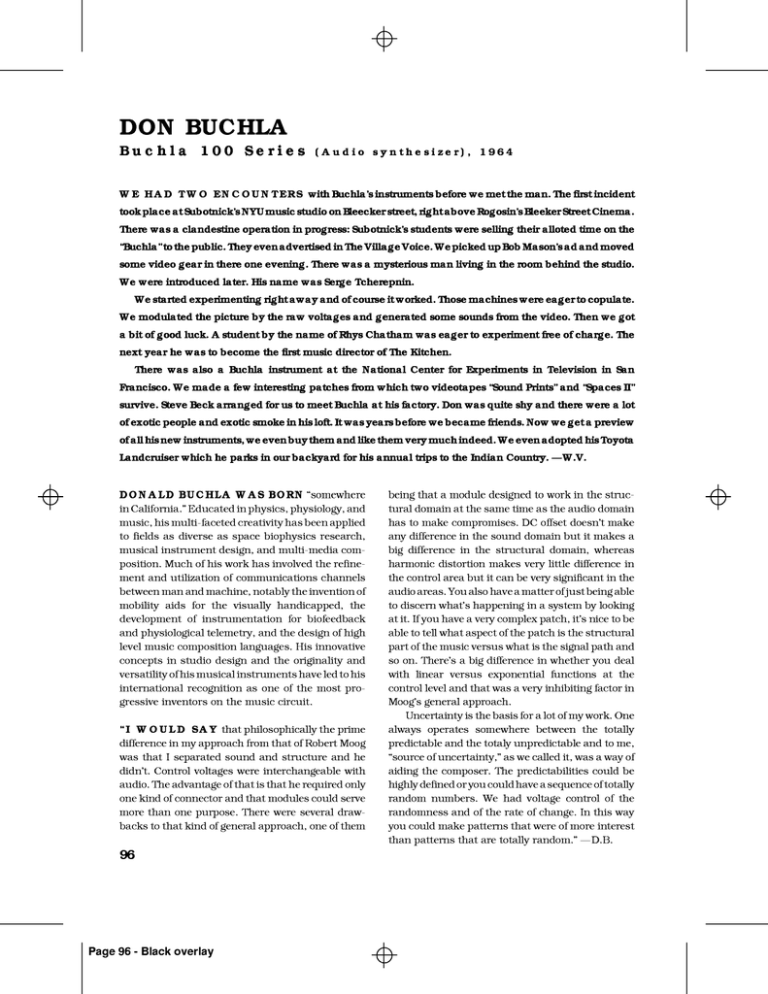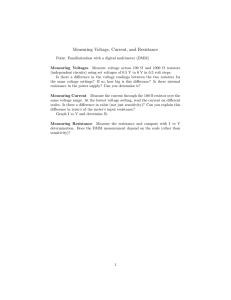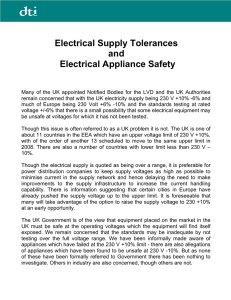Buchla 100 Series (Audio synthesizer) : EIGENWELT
advertisement

DON BUCHLA Buchla 100 Series (Audio synthesizer), 1964 W E HAD TWO ENCOUNTERS with Buchla's instruments before we metthe man.1lie firstincident tookplace atSubotnick'sNYUmusic studio on Bleeckerstreet, rightaboveRogosin'sHeekerStreetCinema . 1liene was a clandestine operation in progress: Subotnick's students were selling theiralloted time on the 'Buchla"tothe public. 1hey evenadvertised inthe Village Voice .Wepicked upBobMason's ad andmoved some video gearin there one evening . 1here was a mysterious man living in the roombehind the studio . We were introduced later. His name was Serge Tcherepnin. We started experimenting rightaway and ofcourse itworked.1hosemachines were eagerto copulate. We modulated the picture by the raw voltages and generated some sounds from the video . Mien we got a bit ofgood luck. A studentby the name ofRhys Chatham was eager to experiment free of charge. 1he nextyear he was to become the first music director ofthe Kitchen. there was also a Buchla instrument at the National Center for Experiments in Television in San Rancisco . We made a few interesting patches from which two videotapes "Sound Prints" and "Spaces 11" survive. Steve Beck arranged for us to meetBuchla at his factory. Don was quite shy and there were a lot of exotic people and exotic smoke in his loft. Itwas years before we became friends. Now wegeta preview ofall his new instruments, we evenbuythem and like them very much indeed. We even adopted his Toyota Landcruiser which he parks in ourbackyard for his annual trips to the Indian Country. -W.V. DONALD BUCHLA WAS BORN "somewhere in California." Educated inphysics, physiology, and music, his multi-faceted creativity has beenapplied to fields as diverse as space biophysics research, musical instrument design, and multi-media composition. Much ofhis work has involved the refinement and utilization of communications channels between man andmachine, notably theinvention of mobility aids for the visually handicapped, the development of instrumentation for biofeedback and physiological telemetry, and the design ofhigh level music composition languages . His innovative concepts in studio design and the originality and versatility ofhis musical instruments haveled to his international recognition as one of the most progressive inventors on the music circuit . "I WOULD SAY that philosophically the prime difference in my approach from that of Robert Moog was that I separated sound and structure and he didn't. Control voltages were interchangeable with audio. The advantage ofthatis thatherequired only one kind of connector and that modules could serve more than one purpose . There were several drawbacks to that kind ofgeneral approach, one ofthem 96 Page 96 - Black overlay being that a module designed to work in the structural domain at the same time as the audio domain has to make compromises . DC offset doesn't make any difference in the sound domain but it makes a big difference in the structural domain, whereas harmonic distortion makes very little difference in the control area but it can be very significant in the audio areas. You also havea matter ofjust being able to discern what's happening in a system by looking at it. Ifyou have a very complex patch, it's nice to be able to tell what aspect ofthe patch is the structural part ofthe musicversus what is the signal path and so on. There's a big difference in whether you deal with linear versus exponential functions at the control level and thatwas a veryinhibiting factor in Moog's general approach. Uncertainty is the basis for a lot ofmywork. One always operates somewhere between the totally predictable and the totaly unpredictable and to me, "source ofuncertainty," as we called it, was away of aiding the composer . The predictabilities could be highly definedoryou could have asequence oftotally random numbers . We had voltage control of the randomness and of the rate of change. In this way you could make patterns that were ofmore interest than patterns that are totally random." -D.B. Buchla 100 Series IIIIIIIIIIIIIIIIIIIIIIIIIIIII FRAME090 step through next 5 frames IIIIIIIIIIIIII STEP BACK IIIIIIIIIIIIII STEP FORWARD EI GEN W ELT D ER A PPA RA TEW ELT BUCHLA 100 SERIES Model 100Cabinet Specially designed walnut cabinet accommodates power supply and 15 panel units . (Most modules are 4 1 /4" x 7" and occupy one panel unit, but some are 8 1/2" or 17" wide and occupy two or four panel units .) Overall dimensions are 23" x 23" x 8". Model 106 Mixer Two 3-channel mixers with both separate and common outputs and level controls for each input . Model 107 Voltage Controlled Mixer Two 5-channel mixers with both separate and common outputs . Input levels are controlled by externally applied control voltages usually derived from a Model 114 touch controlled voltage source . Model 110 Dual Voltage Controlled Gate Two voltage controlled amplifiers generally used in conjunction with a Model 180 attack generator to control the envelope of applied signals . Model 111 Dual Ring Modulator Two independent ring modulators. Each output consists of the sums and differences between frequency components of two input signals. Original signals are suppressed about 55 db. Model 112 Touch Controlled Voltage Source Touch activated keys produce one of twelve preselected voltages at each of two outputs . A third output voltage is proportional to finger pressure, and a fourth output is a pulse generated whenever a key is activated . Generally used to initiate notes and control theirpitches. Model 114 Touch Controlled Voltage Source Tenindependent, touch activated keys, eachwith a corresponding control voltage output and pulse output . Thevoltage outputs are particularly useful for controlling gates (110) or mixers (107), and the pulse outputs for initiating attack waveforms (180) orother events. Model 115 Power Supply Regulated supply for powering a cabinetful of modules plus one or two keyboards . Installed in Model 100 cabinet, unit occupies no panel space . Model 117 Dual Proximity Detector Two capacitance-actuated control voltage sources for enabling spatial control of sound parameters . Theremin-style antennas maybe remotelylocated. 98 Page 9 8 - Black overlay Model 123 Sequential Voltage Source Produces a sequence of two to eight programmed voltages at each of three outputs . Switching is accomplished by applying a pulse, usually from a Model 140 pulse generator . Indicator lamps show which ofthe 24 potentiometers arein control . Eight pulse outputs are energized as corresponding segments are switched. Unit may beusedtosimultaneously program pitch, amplitude, and duration of single or repetitive sequences ofnotes . Model 124 Patchboard Consists of24 miniature audio jacks mounted on a panel . Used in studio installations to facilitate connection to tape recorders, monitors, and other auxiliary equipment . Model 130 Dual Envelope Detector Produces a control voltage proportional to the instantaneous amplitude of an applied signal . Detector time constant is variable from .01 to 1 second . Model 144 Dual Square Wave Oscillator Two independent oscillators in one unit. Frequencies are continuously variable from 5 cps to 20 kc andmay be controlled internally or with externally applied voltages. There is provision for wide band amplitude and frequency modulation. Model 146 Sequential Voltage Source Produces a sequenceoftwo to sixteen programmed voltages at each of three outputs . Otherwise identical to Model 123 . Model 148 Harmonic Generator Generates a fundamental and its first nine harmonics (harmonic numbers 1 - 10) . Fundamental frequency is continuouslyvariable from 5 cps to 5 kc and may be controlled internally or with an externally applied voltage. There is provision for wideband frequency modulation. The 148 is frequently used in conjunction with mixers (106, 107), gates (110), and attack generators (180) to enable precise programmed envelope control of individual overtones. Model 150 Frequency Counter Four digit counter measures frequencies to 100 kc with a precision of 10 cps. Frequencies below 10 kc are measured with a precision of 1 cps . Model 155 Dual Integrator Produces continuous controlvoltagefunctions when used in conjunctionwith sources ofdiscrete control voltages (e.g. keyboards, sequencers) . Positive and DON BUCHLA negative slopes may be individually and continuously varied from 15 volts in .0025 seconds to 15 volts in 10 seconds ; either or both slopes may be voltage controlled. Particularly useful for generating complex voltagecontrolled envelopes, frequency glides, and repetitive control functions . Model 156 Dual Control Voltage Processor Serves to mix, compress and invert control voltages. Each channel has two control voltageinputs and an internal voltage source . Particularly useful for obtaining fine pitch control, transposition capability, and range compression of control voltage sources . Model 157 Control Voltage Inverter Four channel unit complements control voltages to accomplish a variety of inverted functions . Model 158 Dual Sine-Sawtooth Oscillator Two independent oscillators in one unit . Frequencies are continuously variable from 5 cps to 20 kc and may be controlled internally or with externally applied control voltages. Waveshape is continuously adjustable from sine to sawtooth; oscillators may be wideband frequency modulated . Model 160 White Noise Generator Produces white noise with a flatfrequency distribution from 5 cps to 20 kc and weighted noise with a constant power per octave distribution. Model 165 Dual Random Voltage Source Produces two uncorrelated, random output voltages, each ofwhich is changed by applying atrigger pulse. Used to randomize frequency, amplitude, and time . Model 170 Dual Microphone Preamplifier Two high-gain mike preamplifiers . Input connectors are 3 pin XLR. Input impedances are selected by a panel mounted switch . Model 171 Dual Instrument Preamplifier Two preamplifiers for electric guitars, contact microphones, and otherlow-level signal sources . Input impedances are 200 k (omega symbol) ; input connectors are standard phone. Model 172 Dual Signal Leveler Two high-gain, constant-output amplifiers. Output signal levels are maintained at 0 db (plus or minus 1 db) for input variations offrom -40 db to +10 db. Time constants are variable from .05 to 5 seconds . IIIIIIIiumnmuuuuimuuu INFO Frame 18837 to 21366 Page 99 - Black overlay Model 175 Dual Equalizer - Line Driver Used in studio installations to drive 600 (omega symbol) headsets or unbalanced lines at a nominal +4 db (max. +20 db). Unit incorporates bass and treble controls of the variable turnover variety . Model 176 Dual Hiss Cutter Reduces tape hiss by restricting bandwidth of signals that would otherwise be masked by high frequency noise . Signals above a certain threshold (including fast transients) are unaffected. Model 180 Dual Attack Generator Two independent units produce envelope control voltages initiated by pulses . Attack time is variable from .002 to 1 second; decay time from .002 to 5 seconds ; duration from . 002 to 5 seconds . Duration maybe optionally controlled bytrigger pulse length. Model 185 Frequency Shifter Shifts frequencies contained in input signal by an amount equal to the applied carrier frequency . Raised and lowered signals are simultaneously available . Model 190 Dual Reverberation Unit Two independent spring typereverberators. Degree of reverberation is continuously variable . Model 191 Sharp Cutoff Filter Voltage controlled highpass and lowpass filters with 24 db/octave slopes . Cutofffrequencies are variable from 5 cps to 20 kc with no range shifting . Also functions asabandpass filterwithvoltage controlled center frequency and bandwidth . Model 192 Dual Lowpass Filter Two lowpass filters with cutoff frequencies variable from 200 cps to 20 kc. Slopes have sharp knees and are 12 db/octave . Model 194 Bandpass Filter Divides an input signal into four frequency bands. Cross-over frequencies are 200 cps, 900 cps, and 4 kc. Slopes have sharp knees and are 12 db/octave . Model 195 Octave Format Filter Divides an input signal into ten frequency bands centered at octave intervals from 31 cps to 16 kc. Model 196 Phase Shifter Shifts phase ofinput signal such that a 90 degree (plus or minus 5 degree) phase relationship between the two outputs is maintained from 5 cps to 20 kc. Used in conjunction with ring modulators for frequency shifting or for exotic visual displays .




